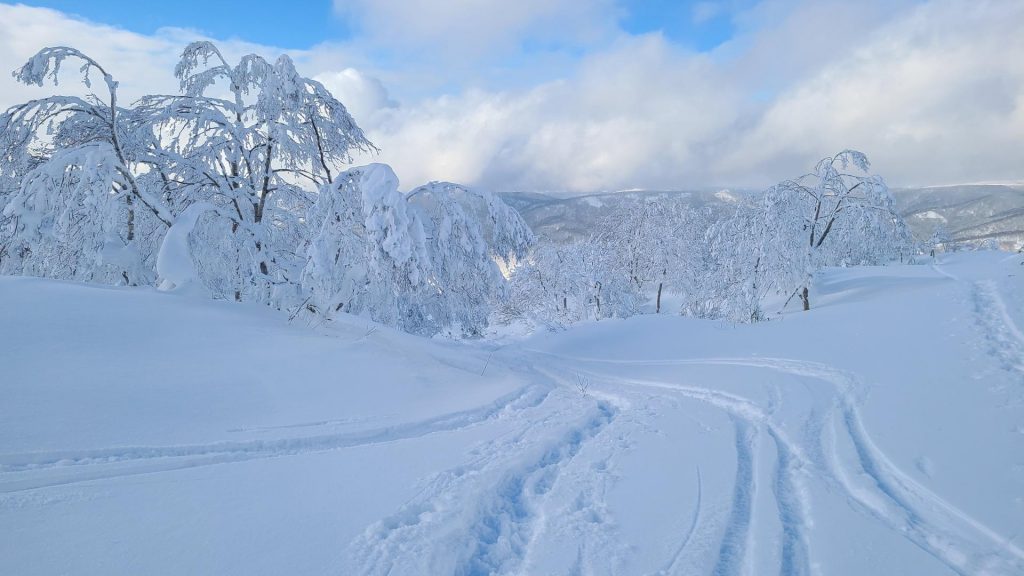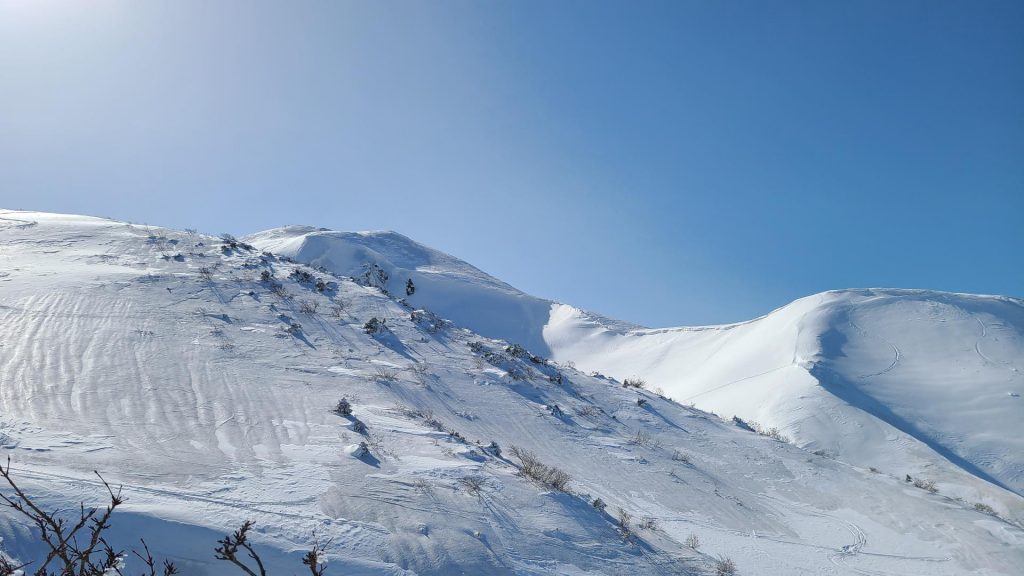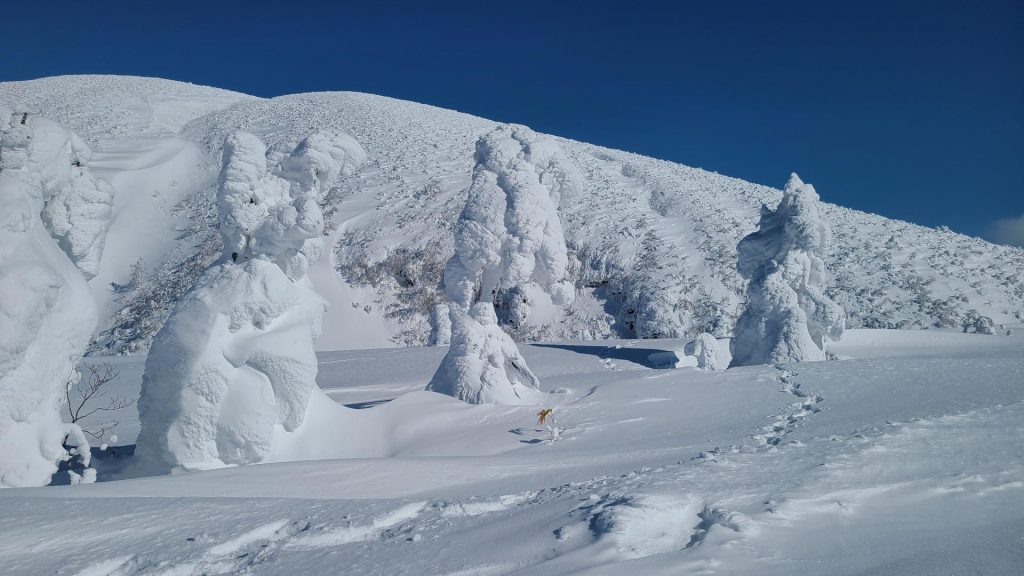
It’s a perfect Friday in early February. The sky is blue and there’s not much wind. While it’s a normal workday for most, there’s a steady trickle of people climbing a cluster of mountains in Akita called Akita Komagatake (秋田駒ヶ岳) or “Akikoma” for short. Some are wearing snowshoes with snowboards strapped to their backpacks, but most are in touring skis fitted with skins, allowing them the traction to hike up the slope toward the central volcano. This is winter touring in northern Japan, a seductive mistress that will lure you back for more.
Hiking trails in Japan generally have official “mountain opening” dates when ceremonies are held and services begin at the mountain lodges along the trails. For example, both Mt. Fuji and Mt. Iwate open on July 1, and a lot of people in Japan mistakenly assume that you’re not allowed to hike during the off season, but that is simply not the case. While winter excursions require different skills, equipment and entail some risk, many venture into the snowy mountains of the north on skis or snowshoes every year.
Akita Komagatake is an area of active stratovolcanoes just 10 kilometers east of Lake Tazawa in Akita. The highest summit is called Onamedake (男女岳), which translates to “Mistress Mountain.” The local story goes that Odake (男岳), or “Man Mountain,” was having an affair with the temptress, Onamedake, despite his marriage to Medake (女岳), which literally translates to “Woman Mountain.” As a result, Medake has erupted in anger many times, most recently in 1971, and is still smoking mad now. This kind of volcanic love triangle is actually not so rare in Japan, and there are similar stories involving other mountains.

During the green season, you can hike the area via a trailhead at Kunimi Hot Springs or even take a bus up to the 8th Station lodge from the Akita side. But in winter, the roads leading to these trailheads are closed and completely covered in snow.
Backcountry skiing, or ski touring, has gained a lot of popularity in Japan over the last few decades. It can be intimidating or scary if you’re new to it. The risk of avalanches or just simply getting lost on a snowy mountain is real. Still, going with a small group that has the necessary equipment can be glorious, even for people that are just starting to venture into the backcountry.
To experience Akikoma during the winter, start at Alpa Komakusa, a facility near Lake Tazawa that has both a hot spring bath and visitor center. Other than right after a fresh snowfall, there’s always a clear track where powder enthusiasts begin the roughly three-hour ascent to the summit of Onamedake (1,637 meters). The first two hours are more or less a straight shot up to the 8th Station lodge, the bottom story of which will be completely buried in snow. However, there’s a door you can enter though on the 2nd floor that gives you access to the bathrooms. There’s also a spacious room with tables you could use to eat—but why would you want to eat inside when you’re surrounded by snowy mountains and frost-covered trees?
On any bluebird day there’ll be a dozen or more people relaxing here before or after their trip up to the summit area, composed both of locals and people from all over Japan. It’s always a festive atmosphere, and people are quick to smile and share information about other snowy peaks they’ve explored.
The last leg of the trip is a steeper ascent to the plateau right below the summit of Onamedake. What most people do is make a sort of base camp here, zip up to the summit, ride down, and repeat! There’s a super wide area, with a completely smooth clear slope to ride down without a tree in sight, so you can enjoy fresh powder even if you’re not one of the first up.
I must admit I snowshoed the route for a few years before I worked up the confidence to do it on skis. But once you get used to the glorious ride down, you’ll never want to trudge back in snowshoes again. Based on the years I’ve spent exploring the mountains of north Japan, I really think Akita Komagatake is both the perfect training ground for people just getting used to touring, and a gorgeous play area for more experienced powder hounds. (There are some very steep, sketchy slopes on the other side of the mountain that provide excitement for those with advanced skills, but I’m not there yet. Be sure to know your limitations of skill and knowledge in the backcountry and go with a friend or small group.)

In addition to the stunning alpine landscape, which even boasts a small area of snow monsters just below the 8th Station, another plus for novice backcountry skiers is that the terrain ascends all the way up without any dips into valleys, meaning you don’t have to take off and put back on skins multiple times or fiddle with your bindings. And the way back is all smooth sailing downhill, no awkward sideways slope climbing on skis or stopping to put your skins back on for a short ascent. It’s perfect.
Of course this entire area is also a great snowshoe hike, albeit a long one. When you have to walk all the way back down, it can easily be a six-hour round trip. It is absolutely worth it though. And if you have any luck, you’ll make friends along the way—maybe even get invited up to one of the other glorious mountains nearby, like Moriyoshi or Hakkoda. Akita Komagatake may very well be the gateway drug to a backcountry addiction. Once you’ve started, Tohoku is full of dreamy mountains where you can get your fix!
Quinlan Faris has been living in Japan for more than 20 years, the last 12 in the wilds of the north. He is based in Morioka, Iwate, where he wears a variety of hats—working as a guide, inbound tourism advisor, narrator, and video creator—all while running a small Airbnb out of the building where he lives. You’ll most likely find him up a local volcano, hiking through a storm or foraging for wild edibles along a mountain stream to feed his guests or entertain his YouTube subscribers. Follow his adventures at youtube.com/c/GoNorthJapan and Instagram @quinlan.




